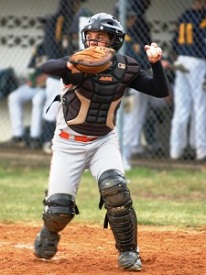When it comes to baseball, being left-handed is usually seen as a bonus.
Left-handed pitchers are often the most valuable pitchers in the game and first basemen who are left-handed are big assets. Being able to hit left-handed is a skill that many right-handed players strive to master.

However, left-handed catchers are incredibly rare and in many situations, they are frowned upon. Interestingly, there are many right-handed catchers who actually bat left-handed. But, you will rarely, if ever, see professional baseball catchers who are catchers and left-handed. Why is that?
The Rarity of Left-Handed Players in Baseball
The majority of reasons come down to dynamics of being a left-handed catcher in the world of right-handed batters. Someone who is left-handed throws with their left hand and catches with their right hand. When right-handed hitters are up to bat, a right-handed catcher who uses the left hand to catch has the hand positioned closest to the batter’s body. This makes it easier for the right-handed catcher to make the catch on inside pitches. A left-handed catcher would have to come across the body to make an inside catch and this is a more difficult catch to make. There are significantly more right-handed batters in the game of baseball.
The Challenges of Throwing from the Left

When a left-handed catcher has to make throws to the bases, there are some challenges. To get the throw to third base, the catcher would have to move his entire body to get past the batter and complete the throw. This is not the case for a right-handed catcher who simply has to make the transfer and then the throw. Since there are fewer left-handed batters, this issue does not arise when right-handed catchers need to throw to first base.
The Safety of the Home-Plate Tag
Another reason that left-handed catchers are not often used in baseball has to do with making the tag at home plate. When a right-handed catcher prepares to make the tag, the catching hand helps protect the catcher’s body. This is not the case with a left-handed catcher who would have a fully exposed body for a spike-wearing baserunner to hit. Since the world of sports is dedicated to making games safer, exposing a player to a base runner will keep more coaches from encouraging left-handed players from becoming catchers.
The Speed of Throwing to Second

Another issue with being left-handed and behind the plate comes with the throw to second base. When a right-handed batter is at the plate (which is usually the case), the left-handed catcher would need to move out of the way of the batter to throw the ball. The throw down to second needs to happen as quickly as possible, so getting out of the way of the batter needs to be removed from the situation.
The Lack of Proper Gear for Left-Handed Players
One of the biggest issues with baseball and left-handed players is the lack of proper gear. Most sporting goods stores carry very few left-handed baseball gloves. This is because there are so few players who are left-handed, leaving the market underwhelmed.
Since the catcher’s mitt is so specialized, it is nearly impossible to find a left-handed catcher’s mitt. This means that anyone who wants to catch and is left-handed has to order one directly from the manufacturer and it can be expensive to order.
Left-handed catchers also need to have chest protectors that are designed for their stronger hand, with protection over their left shoulders, rather than their rights. Being left-handed in the world of baseball can be expensive. Although rare, some of the mitts we feature are made for lefties as well!
How to Get Young Lefties to Catch
When it gets down to the actual game, the issue comes to the kids who begin playing at a young age. In reality, when a coach gets a left-handed player, that coach is more likely to put the player at first base or in right field. Many coaches will also suggest that the left-handed player learn how to pitch. In reality, left-handed pitchers are one of the hottest commodities in all of sports and they are so desirable that they do not even have to pitch as quickly as a right-handed pitcher does. Most coaches will not put a left-handed player at catcher because of what happens at the Major Leagues. Until young left-handed players become catchers in Little League and on travel ball teams, the status quo will remain.
The same goes for the affordability and availability of left-handed catcher’s mitts. No one wants to be a catcher with a glove that is not designed for a catcher. Little hands will hurt after catching a few pitches and the child will want to move into another position. Even if manufacturers provided stores with one or two left-handed catcher’s mitts in different sizes, younger players and their parents would be more willing to put their children in the fun position.
Comments are closed.